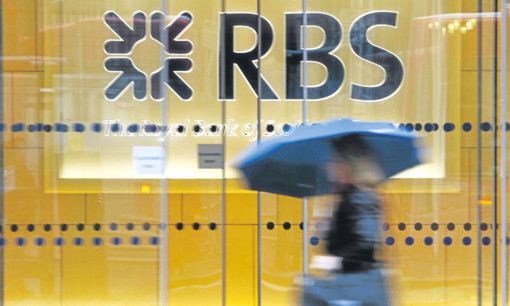
ROYAL Bank of Scotland (RBS) has reported a £7 billion annual loss and announced a major cost-cutting drive expected to result in large-scale job losses.
The taxpayer-backed bank has racked up nine consecutive years of losses and this figure represents a hefty increase on the £2 billion loss the lender reported last year and is one of the group’s biggest since its Government bailout in 2008.
Chief executive Ross McEwan has ordered a £2 billion four-year cost-cutting drive, expected to result in significant job losses and branch closures.
It will include £750 million of savings this year, but Mr McEwan refused to be drawn on how many jobs will be lost.
He said: “There will be job-losses that we will have to go through to get this business back into shape.”
“I will not give job numbers out, I’ll talk to staff first before anyone else. The £2 billion needs to come out and will be broad-ranging – people, property, across the board.
He also addressed speculation surrounding his own position.
When asked if he expects to be at the bank next year, the New Zealander said: “I hope so. We have done a lot of hard work, and I sense this bank is on the turn.
“It’s my strategy, I’d like to see it concluded.”
The lender, which is 72% owned by the taxpayer, has been stung by billions in restructuring, conduct and litigation charges.
Friday’s figures take into account £10 billion in legacy costs, including £5.9 billion on conduct charges and a £2.1 billion restructuring hit.
The group revealed recently it had set aside another £3.1 billion ahead of an expected fine from US authorities, linked to the sale of mortgage-backed securities, which was included in the bank’s results.
RBS has now notched up losses totalling more than £55 billion over the past eight years.
Shares in the bank fell by over 2% in morning trading.
Mr McEwan said of the results: “The bottom-line loss we have reported today is, of course, disappointing but, given the scale of the legacy issues we worked through in 2016, it should not come as a surprise.
“These costs are a stark reminder of what happens to a bank when things go wrong and you lose focus on the customer, as this bank did before the financial crisis.”
But Mr McEwan said he expects the bank to be profitable by next year and pointed to its underlying adjusted operating profit of £4.2 billion, which strips out exceptional charges.
“We made good progress throughout 2016 against our strategy. Our core business generated £4.2 billion in adjusted pre-tax operating profit for the year – that’s an average of £1 billion per quarter for the last eight quarters,” he said.
“We were the fastest-growing large bank in the UK last year, with £24 billion of new lending into the economy supporting over a million businesses and home-owners.
“This bank has great potential. We believe that by going further on cost reduction and faster on digital transformation, we will deliver a simpler, safer and even more customer-focused bank.”
The result comes a week after the Treasury proposed a plan to abandon the sale of RBS’s Williams & Glyn branch network, which will cost the lender £750 million.
The bank had been required to offload Williams & Glyn by the end of the year as part of EU conditions on its £45 billion bailout at the height of the financial crisis.
The lender has struggled to offload the branches, which it was required to do by the end of the year under state aid rules.

Enjoy the convenience of having The Sunday Post delivered as a digital ePaper straight to your smartphone, tablet or computer.
Subscribe for only £5.49 a month and enjoy all the benefits of the printed paper as a digital replica.
Subscribe